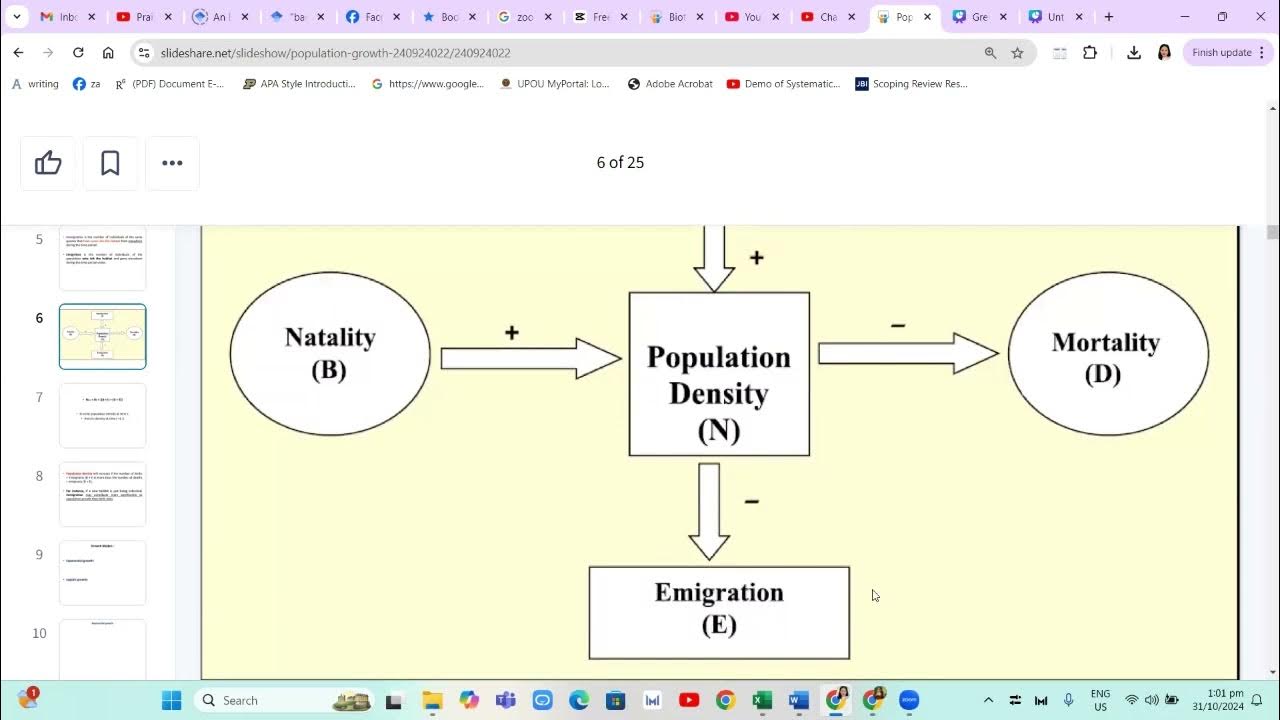Logistic Differential Equation (general solution)
Summary
TLDRThis video tutorial explains the logistic differential equation, a model for population growth with a carrying capacity. The presenter demonstrates how to solve it by separating variables, integrating, and using partial fractions. The solution leads to the logistic growth equation, which describes how populations approach their carrying capacity. The video concludes with finding the constant 'C' using the initial population, making it a practical tool for predicting population dynamics.
Takeaways
- 📐 The logistic differential equation models population growth with a carrying capacity, represented as 'm'.
- 🔄 The rate of population change is proportional to both the population and a factor involving 1 minus P/m.
- ✅ To solve the logistic equation, variables are separated and integrated.
- 🔢 The equation is manipulated to isolate terms involving 'P', the population variable.
- 📉 The process involves multiplying by 'm' to combine like terms and simplify the equation.
- 📚 Partial fractions are used to break down complex fractions for easier integration.
- 🤔 The 'cover-up' method is introduced to determine constants in partial fractions.
- 📈 Integration of both sides of the equation leads to the use of natural logarithms.
- 🔄 The derivative of M - P with respect to P is considered to simplify the equation further.
- 🌱 The final form of the logistic growth equation is P = m / (1 + C * e^(-K*T)), where 'C' is a constant determined by initial conditions.
- 📋 The constant 'C' can be calculated using the initial population and the carrying capacity.
Q & A
What is the logistic differential equation?
-The logistic differential equation is a model for population growth that includes a carrying capacity, denoted as 'm'. It states that the rate of change of the population with respect to time is proportional to the population itself and to the factor (1 - P/m), where P is the population size.
What does the term 'carrying capacity' represent in the logistic differential equation?
-The 'carrying capacity' (m) represents the maximum population size that the environment can sustain indefinitely.
How does the logistic differential equation account for population growth?
-The logistic differential equation accounts for population growth by incorporating a term that reduces the growth rate as the population size approaches the carrying capacity, thus preventing unlimited growth.
What is the significance of the term '1 - P/m' in the logistic differential equation?
-The term '1 - P/m' represents the fraction of the carrying capacity that is not yet occupied by the population. It ensures that the growth rate decreases as the population approaches the carrying capacity.
How is the logistic differential equation solved?
-The logistic differential equation is solved by separating variables and integrating both sides. This process involves manipulating the equation to isolate terms involving 'P' on one side and terms involving 'dt' on the other.
What is the role of the constant 'K' in the logistic differential equation?
-The constant 'K' is an integration constant that arises during the separation of variables and integration process. It represents the initial condition of the differential equation.
What does the term 'partial fractions' refer to in the context of solving the logistic differential equation?
-In the context of solving the logistic differential equation, 'partial fractions' refers to a technique used to decompose a complex fraction into simpler fractions that can be integrated more easily.
How does the video script describe the process of integrating the logistic differential equation?
-The video script describes the integration process by first multiplying both sides by 'm' to combine like terms, then using partial fractions to decompose the complex fraction, and finally integrating both sides to find the solution.
What is the final form of the logistic growth equation as presented in the video script?
-The final form of the logistic growth equation presented in the video script is P(t) = m / (1 + C*e^(-K*t)), where P(t) represents the population at time 't', m is the carrying capacity, C is a constant related to the initial population, and K is the growth rate constant.
How is the initial population size related to the constant 'C' in the logistic growth equation?
-The initial population size (P_0) is related to the constant 'C' by the formula C = (m - P_0) / P_0, where m is the carrying capacity and P_0 is the initial population size.
What does the 'C' term represent in the logistic growth equation?
-The 'C' term in the logistic growth equation represents the ratio of the difference between the carrying capacity and the initial population to the initial population itself.
Outlines

هذا القسم متوفر فقط للمشتركين. يرجى الترقية للوصول إلى هذه الميزة.
قم بالترقية الآنMindmap

هذا القسم متوفر فقط للمشتركين. يرجى الترقية للوصول إلى هذه الميزة.
قم بالترقية الآنKeywords

هذا القسم متوفر فقط للمشتركين. يرجى الترقية للوصول إلى هذه الميزة.
قم بالترقية الآنHighlights

هذا القسم متوفر فقط للمشتركين. يرجى الترقية للوصول إلى هذه الميزة.
قم بالترقية الآنTranscripts

هذا القسم متوفر فقط للمشتركين. يرجى الترقية للوصول إلى هذه الميزة.
قم بالترقية الآن5.0 / 5 (0 votes)






